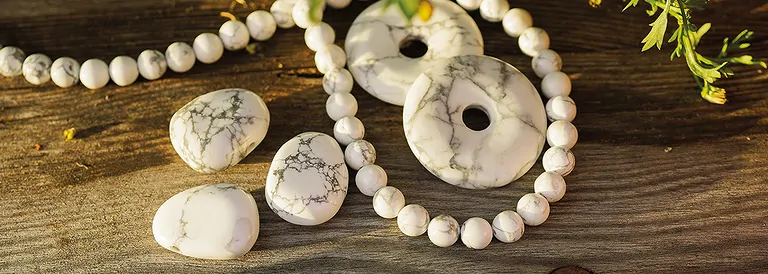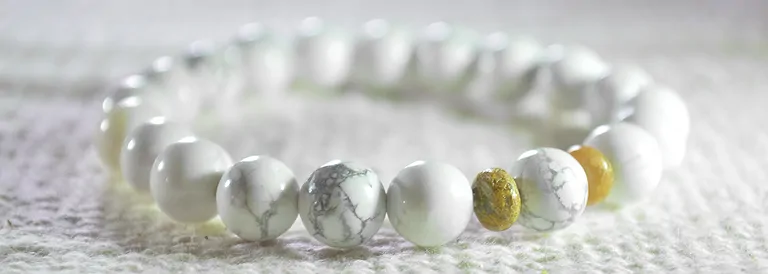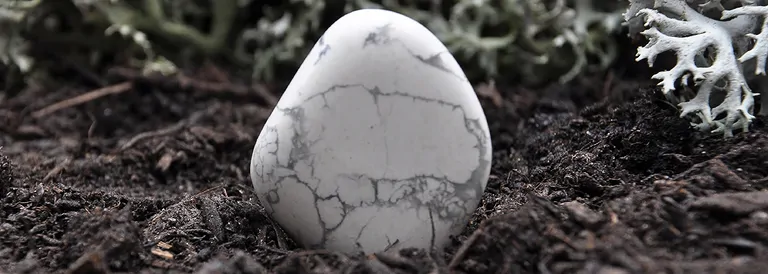
Magnesite - meaning, effort and application
In dynamic or turbulent times, magnesite gives us relaxation and serenity. With the help of the white stone, we can take ourselves back a little and listen more closely to what our fellow human beings have to say to us. Patience and resilience are strengthened, irritability and hecticness are reduced. This creates an overall life-affirming mood and we can accept and love ourselves.

Mineralogical profile of magnesite
Chemical formula: Mg[CO3]
Mineral class: Carbonates and nitrates
Formation: sedimentary from the weathering of magnesium-containing rocks or as precipitation from hydrothermal solutions
Color: white to greyish with grey veins, rarely beige-brown or light green
Luster: vitreous luster, matt
Crystal system: trigonal
Mohs hardness: 3.5 - 4.5
Cleavage, fracture: perfect cleavage according to the rhombohedron; conchoidal fracture
Occurrence, main supplier countries: worldwide, e.g. Australia, Brazil, China, Norway, Austria, Poland, Russia, Sweden, Zimbabwe, Turkey, USA. Mainly magnesite from China, Turkey, Brazil, Russia and Austria is traded. Popular yellowish-green collector specimens come from the Clara mine in Oberwolfach in the Black Forest.
Appearance: rock-forming in large masses or in bulbous aggregates
Use: Magnesite is used as a raw material for insulation material, e.g. refractory bricks, in blast furnaces due to its refractoriness up to approx. 3000°. Due to its high heat storage capacity, magnesite is also used as a storage material in night storage furnaces and as an insulating material.
As magnesite can be easily dyed, the material is also often used in the jewelry industry; the blue-green turquenite used as an imitation turquoise, for example, is well-known.
In gemstone healing, magnesite conveys serenity, relaxation, patience, devotion, self-affirmation, self-love and promotes the ability to listen. In astrology, it is used to bring calm to Aquarius-born people in particular.
Tumbled stones, stringed beads and other magnesite items at wholesale prices

Name and Synonyms of Magnesite
The first documented discovery of magnesite was made in Moravia in 1803, the first scientific description was written by Abraham Gottlob Werner (1749 - 1817) under the name "pure talc" (talcum carbonatum, magnesia nativ carbonatee). The mineral was given its final name magnesite in 1808 after its metallic component magnesium by the Privy Oberbergrat Dietrich Ludwig Gustav Karsten (1768 - 1810).
Well-known synonyms for magnesite are bitter spar and talc spar, less common are baldisserite, bandisserite, baudisserite, giobertite, carbonic acid bitter earth or talc earth, mesitite and roubschite. Beige-brown magnesite is also called ivoryite or ivory magnesite.
Pinolite from Austria, a mixture of magnesite, dolomite and graphite, is known as ice flower magnesite. A nickel-containing magnesite (nickel magnesite) from Australia can be found on the market under the misleading name lemon chrysoprase, while hoshiite (choschiite) is a magnesite from China colored green by nickel. Wild horse magnesite is the trade name of a brown-white magnesite with hematite from Arizona (USA), which is mainly used in pendants, rings and other pieces of jewelry.

More information about ice flower magnesite (pinolite)
Use of magnesite in gemstone healing
Magnesite is always important for gemstone wellness - e.g. gemstone massage or gemstone water - when relaxation and serenity are required. Magnesite is one of the seven main stones in Monika Grundmann's Gemstone Balance treatment concept. The themes of magnesite are letting go and emphasizing the positive aspects of life so that inner peace is strengthened.
White magnesite supports the ability to listen to oneself so that inner peace can return. It helps you to accept and love yourself. Life can be approached in a relaxed and calm manner - negative things are left behind and the positive aspects are lived out with dedication. A wonderful stone after a stressful day! Under the guiding theme of magnesite "I let go!", Gemstone Balance offers numerous applications with massage stylus, phoenix wings and other stone forms.
Suitable for everyday use is Magnesite also as a water stone. Magnesite is therefore available in various mixtures both as pre-tumbled water stones for direct insertion and as water sticks in various sizes.
Magnesite is also popular as a thumb stone, touch heart or other polished form as a hand flatterer and pocket stone. In everyday life, it reminds to remain calm and relaxed and not to let external circumstances upset us and make us lose our cool.

Magnesite and Howlite
Magnesite and howlite are visually very similar but mineralogically very different. As howlite is a calcium silicate, howlite can be easily distinguished from calcium carbonate magnesite using the carbonate test. The gemstone known commercially as howlite is - especially in polished form - almost exclusively magnesite. This misnomer is derived from the internationally common but misleading trade name "white howlite" for magnesite. The only commercially used location for howlite is in Utah (USA) and has been closed for years.